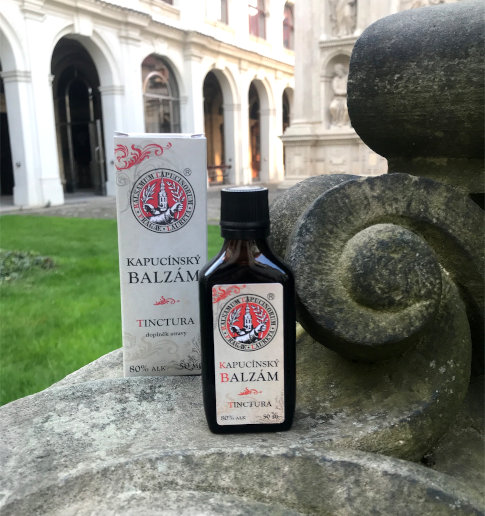Capuchin Balm
In the Capuchin Crypt there you can buy now a tincture made according to an ancient Capuchin recipe from the time of Rudolf II.
Some natural products can be said to be time-tested. In the case of capuchin balm, the time is respectably long: it was produced from the mid-18th century until 1950. Now, after a seventy-year break, the secret recipe comes to life again and turned into a tincture returns to the market.
The production of balm was associated with the Hradčany monastery pharmacy (1680–1822), but it managed to assert itself even after pharmacis abolition. The tincture was used for stomach cramps, toothache, but it also worked in wound healing and helped from muscle and joint pain. The balm was so famous that the brothers sold it not only in the Hradčany monastery and also in other Capuchin convents in Bohemia and Moravia. From the second half of the 19th century, it was even exported abroad: Germany, Poland, Belgium, Ireland and the USA. During World War II, production suffered greatly and with the liquidation of the monasteries by the Communists in 1950 it finally ended.

The tradition of making drops has been broken. The secret recipe had to be carefully stored to prevent theft or misuse. The drops disappeared from the pharmacy counters and slowly faded into oblivion. „And we, with respect for our resourceful brothers and with the hope that they would continue to be effective, helped them to come back to the world after a long pause. Thanks to my predecessor, Brother Bonaventura, who began this beneficial work," says Brother Dismas Tomaštík, Provincial of the Capuchin Order.

It is clear from archival sources that the Capuchin Balm is a variant of the famous Balsamum vulnerarium by the German physician Oswald Croll (1563–1609), who also worked in Prague at the court of Rudolf II. The main ingredients are fragrances of natural origin: Peruvian balm, myrrh, frankincense and styrax. Together with sandalwood, St. John's wort flowers, angelica root and other dried plants, they are macerated in alcohol. After filtration, a tincture with antiseptic, anti-inflammatory and analgesic effect is formed. Capuchin balm was a popular remedy for internal and external use.
Capuchin balm. Herbal drops, 50 ml. Ingredients: alcohol 80%, purified water, extracts from trees and herbs. Dosage: 10 drops per day. The amount can be divided into two batches. The measured amount can be dripped on a teaspoon, into a glass of water or onto a cube of sugar (internal use). External use: rubbing the affected area. Alcohol content: 80%.
